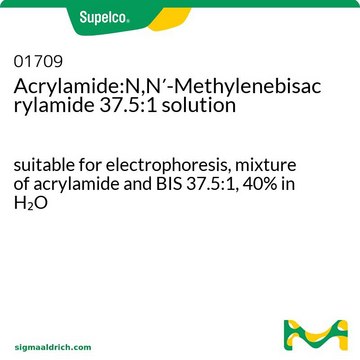A6050
Acrylamide/Bis-acrylamide
BioReagent, for molecular biology, 37:1 (ratio)
Synonym(s):
Acrylamide/Bisacrylamide, 37:1 (2.6% crosslinker), Polyacrylamide solution
About This Item
Recommended Products
grade
for molecular biology
Quality Level
product line
BioReagent
form
powder
feed ratio
37:1 (ratio)
foreign activity
DNase, RNase and protease, none detected
SMILES string
NC(=O)C=C.C=CC(=O)NCNC(=O)C=C
InChI
1S/C7H10N2O2.C3H5NO/c1-3-6(10)8-5-9-7(11)4-2;1-2-3(4)5/h3-4H,1-2,5H2,(H,8,10)(H,9,11);2H,1H2,(H2,4,5)
InChI key
OCQZXMCGTAWGEQ-UHFFFAOYSA-N
Looking for similar products? Visit Product Comparison Guide
General description
Application
Features and Benefits
Reconstitution
For the 1 Liter size, use 630 mL of water.
Signal Word
Danger
Hazard Statements
Precautionary Statements
Hazard Classifications
Acute Tox. 3 Oral - Acute Tox. 4 Dermal - Acute Tox. 4 Inhalation - Carc. 1B - Eye Irrit. 2 - Muta. 1B - Repr. 2 - Skin Irrit. 2 - Skin Sens. 1 - STOT RE 1 Oral
Target Organs
Peripheral nervous system
Storage Class Code
6.1C - Combustible acute toxic Cat.3 / toxic compounds or compounds which causing chronic effects
WGK
WGK 3
Flash Point(F)
Not applicable
Flash Point(C)
Not applicable
Personal Protective Equipment
Regulatory Listings
Regulatory Listings are mainly provided for chemical products. Only limited information can be provided here for non-chemical products. No entry means none of the components are listed. It is the user’s obligation to ensure the safe and legal use of the product.
PDSCL
Deleterious substance
PRTR
Class I Designated Chemical Substances
ISHL Indicated Name
Substances Subject to be Indicated Names
ISHL Notified Names
Substances Subject to be Notified Names
JAN Code
A6050-1L:4548173186634
A6050-VAR:
A6050-BULK:
A6050-100ML:4548173186627
A6050-5X100ML:4548173186641
Certificates of Analysis (COA)
Search for Certificates of Analysis (COA) by entering the products Lot/Batch Number. Lot and Batch Numbers can be found on a product’s label following the words ‘Lot’ or ‘Batch’.
Already Own This Product?
Find documentation for the products that you have recently purchased in the Document Library.
Customers Also Viewed
Our team of scientists has experience in all areas of research including Life Science, Material Science, Chemical Synthesis, Chromatography, Analytical and many others.
Contact Technical Service





